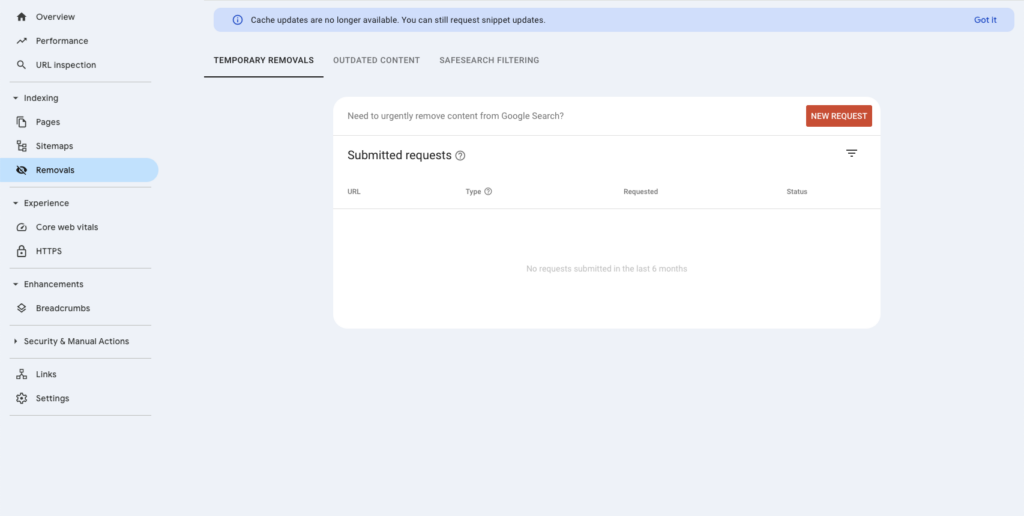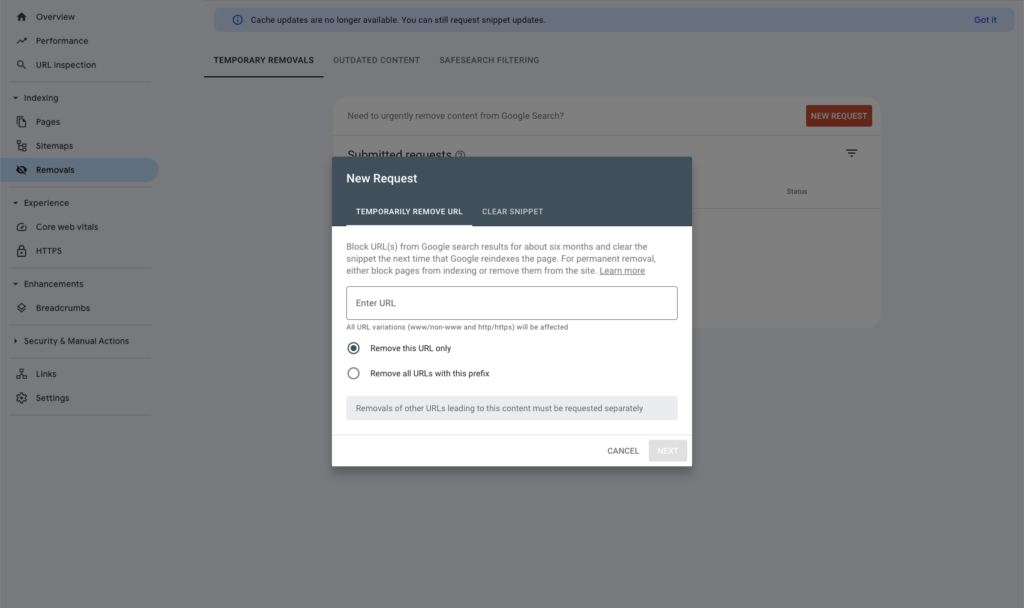
If you need to remove a website from Google Search, whether it’s your own or someone else’s, there are several ways to do it. Whether you have outdated content, private information exposed, or an old website you no longer want to appear in search results, this guide will walk you through the process step by step.
For context, this morning I checked Google to see what pages from my site were being indexed and to my shock there were pages indexed that really should not have been there. I found development url, test sites, pdfs from private directories. I needed to sort this out which lead me to thinking ‘how do I remove a website from Google Search’?
PS: If you want to check yourself which pages from your domain are being indexed on google you can search this:
site:your-domain.comWhy Remove a Website from Google?
There are many reasons why you might want to remove a website from Google search results. Here are some of the most common:
1. Outdated or Incorrect Information
If your website contains outdated details that mislead visitors, you may need to remove or update the content to avoid confusion.
2. Duplicate Pages or Websites
If Google has indexed duplicate versions of the same page, it can negatively affect your site’s SEO and confuse users.
3. Leaked Private Information
If sensitive personal or business details have been made public, removing them from Google is a priority.
4. Cached Content Still Appearing in Search Results
Even if you’ve deleted or updated a page, Google might still show an older version of it until it gets around to scanning the site again.
5. Hacked or Compromised Websites
If a website has been hacked and is now hosting malicious content, it should be removed from Google immediately to protect visitors.
How to Remove a Website from Google Search
Removing a website from Google is a multi-step process. Here’s how to do it properly:
Step 1: Backup Your Website
Before making any changes, create a backup of your website in case you need to restore it later.
Step 2: Use the Removals Tool for Temporary Removal
Google’s Removals Tool which can be found inside Google Search Console lets you remove a page from search results within a day. However, this removal only lasts for six months.

All you need to do here is to click New Request and you will be presented with this:

Simply enter the web page url that you wish to remove and click Next. Confirm your selection.
This will temporarily remove the url from Google searches for six months. All you need to do now is make sure there is not reason for Google to reindex it again in six months.
Step 3: Make the Removal Permanent
To ensure the page doesn’t reappear, you need to take one of the following actions:
1. Delete or Update the Page
Removing the page entirely ensures that all search engines (not just Google) will no longer show it.
2. Password-Protect the Page
If you want to restrict access, you can set up password protection so only authorised users can view it.
3. Add a Noindex Meta Tag
Adding a noindex tag to the page’s HTML tells Google not to list it in search results.
4. Avoid Relying on robots.txt
A robots.txt file can block Google from crawling a page, but if other websites link to it, Google may still index it.
Step 4: File a URL Removal Request
Once you’ve taken action, submit a URL Removal Request via Google Search Console to speed up the process.
Step 5: Request Google to Recrawl Your Site
If you’ve updated or removed pages, ask Google to re-index your site via Google Search Console.
Step 6: Remove Cached Content from Google
If an outdated page still appears, use the Outdated Content Removal Tool to clear Google’s cache.
Step 7: Delete Content from the Wayback Machine
If your website has been archived on the Wayback Machine, request removal by emailing [email protected].
How to Remove Images from Google Search
If images from your website appear in Google Images and you want them removed, follow these steps:
- Delete the Image – Remove it from your website or block access to it.
- Use the Removals Tool – Submit an image removal request via Google Search Console.
- Block Search Engine Access – Add a
noindexdirective for the image in your robots.txt file.
Frequently Asked Questions
Can I Remove a Website from Google Search that I Don’t Own from Google?
Yes, but only under specific circumstances, such as:
- If it violates legal policies, you can submit a legal removal request.
- If the content is outdated, you can request removal using the Outdated Content Removal Tool.
- If it contains personal data, use Google’s Personal Information Removal Request.
Can I Remove a Website from Google Search that I Don’t Own from Google?
Yes, but only under specific circumstances, such as:
- If the content is outdated, you can request removal using the Outdated Content Removal Tool.
- If it contains personal data, use Google’s Personal Information Removal Request.
- If it violates legal policies, you can submit a legal removal request.
Does Removing a Website from Google Also Remove It from Other Search Engines?
No, removing a site from Google does not remove it from Bing, Yahoo, or other search engines. You will need to contact each search engine separately.
How Long Does It Take to Remove a Website from Google search?
Temporary removals take around 24 hours, while permanent removals can take several weeks. When I ran this today, the pages were gone within a few hours. To be fair I was really impressed with the speed of the removal.
Will Deleting a Website Remove It from Google Immediately?
No, Google may still display a cached version of your website. You must request cache removal separately.
Can I Remove My Business Listing from Google Search?
Yes, if you want to remove a Google Business Profile, you can delete or update your listing via Google Business Profile Manager.
Master WordPress and SEO with WP Odyssey
Want to take full control of your WordPress website and improve your SEO skills? At WP Odyssey, I teach beginners and intermediate WordPress users how to build, manage, and grow websites effectively. Whether you want to optimise your SEO, improve security, or master WordPress as a business, my Skool course has you covered.
👉 Join WP Odyssey today and start mastering WordPress!
By following this guide, you can successfully remove unwanted pages from Google search results while ensuring your website remains optimised and secure. Feel free to start a discussion below in the comments or explore more posts on our blog.
